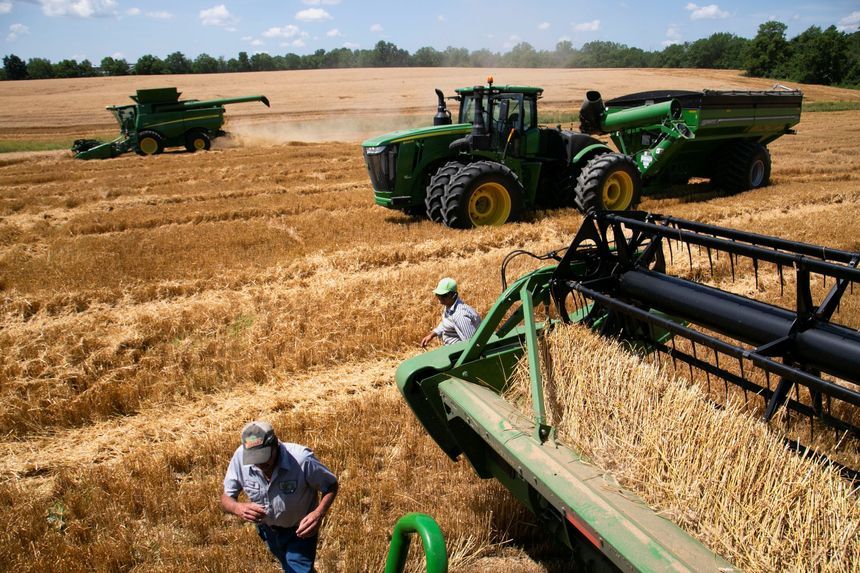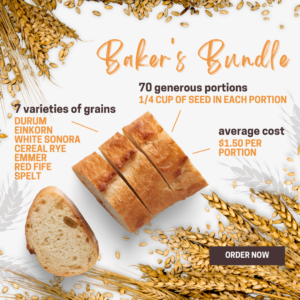Seed Saving Blog

Global Wheat Crisis: What Gardeners Can Do to Help
If you’ve been following world news in the past year or two, you’ve probably heard predictions of worldwide grain shortages in the near future. Fuel costs, bizarre weather events and financial crises are all seen as pointing to an impending famine of global proportions.
Much of the information in this post has been widely reported in the media. If you want to review a brief summary of the problems, read on. If you prefer to skip to the positives and action steps that you can take, scroll down.
Bread and other wheat products are fundamental elements in maintaining world stability. From flour to pasta and thickening agents to cereal, the versatility, dependability and affordability of wheat make it crucially important for international food security — and it’s getting precariously scarce and expensive. Currently, an unusual convergence of crises, including war, extreme weather, crop failures, inflation, rising energy prices and transport costs, are driving major disruptions in the wheat supply across the globe.
The full extent of these disruptions is yet to be felt, but supply issues are making international headlines because of wheat’s nearly universal importance to diets across the world. This is what we were hearing in May 2022 (then view the August update here.)
Russia and Ukraine: Following the Russian invasion of Ukraine, a country known as ‘the breadbasket of Europe’, wheat prices are soaring to record highs. Ukraine has called for safe passage for its wheat. What hasn’t been allegedly stolen by Russian forces has been stuck in fields, in storage or in shipping ports as Russia continues its attacks on the country. According to the United Nations, without grain from Russia and Ukraine, which prior to the war were the first- and third-largest wheat exporters, respectively, the global food crisis is getting worse.
Precariously Low Supplies: Recent comments made to the UN Security Council by Sara Menker,CEO of Gro Intelligence, are alarming. According to Menker:
Official government agency estimates from around the world put wheat inventories at 33% of annual consumption. Verifiable data from public and private sources that we as a company organize and then build statistical models to connect the dots between in our platform show that global wheat inventories are in fact closer to 20%, a level not seen since the financial and commodity crisis of 2007 and 2008. We currently only have 10 weeks of global consumption sitting in inventory around the world. Conditions today are worse than those experienced in 2007 and 2008. It is important to note that the lowest grain inventory levels the world has ever seen are now occurring while access to fertilizers is highly constrained, and drought in wheat growing regions around the world is the most extreme it’s been in over 20 years. Similar inventory concerns also apply to corn and other grains. Government estimates are not adding up. 1
In brief, Menker’s remarks indicate that the world currently has a wheat inventory that can only meet 20% of the expected demand. Her full comments clearly and succinctly outline the state of global grain access and the reasons for the shortage. Read the full transcript of her comments at https://gro-intelligence.com/blog/gro-s-ceo-sara-menker-briefs-the-united-nations-security-council.
Protectionism: To make matters worse, scarcity and inflation are spurring countries to put export controls in place. At this writing, 14 countries are implementing protectionist measures, banning wheat exports in an attempt to prevent domestic shortages and stabilize rising food prices.
Wheat Outlook in the U.S.: According to DTN2, an agricultural data firm, U.S. winter wheat was rated 28% Good to Excellent, the lowest such rating since the drought of 1989 and bad news for supplies. As of this writing, the price of wheat is $12.01 a bushel, not great news for consumers. But it may have a silver lining— farmers, who keep a close eye on commodity prices may be spurred to plant more wheat in the coming year despite rising fertilizer and fuel costs.
Despite the challenges that the world faces, we are not helpless. Gardeners, in particular, have been handed the great opportunity to make a difference for ourselves, our families and our communities. Here are a few actions we can take to help:
Focus on Saving Seeds: Food shortages and rising food costs tend to trigger a rush to buy garden seeds. High demand triggers scarcity and drives up prices. One of the best things we can do is save seeds from our own gardens and share them with others.
What Else Can We Do to Help? The world can only hope that a strong wheat harvest will save the most vulnerable countries from increased food instability. But if that is not the case, gardeners have skills that can help to ameliorate the situation.
- Grow food: One backyard gardener may not make much difference to the food supply. But together, millions of gardeners across the world who commit to growing a portion of their own food can make a significant impact.
- Grow food without chemicals: Constrained access to fertilizers is one of the factors driving the wheat crisis. Using natural systems to feed plants and soil, like composting, no-till soil management and chop and drop mulching, backyard farmers can grow wheat without chemical fertilizers.
- Grow grains: Wheat supplies may be tight, but consider that a plot roughly the size of the average kitchen table can grow enough wheat for a hefty loaf of bread. And you can get two harvests out of one plot by planting winter wheat in the fall, followed by spring wheat after the winter wheat harvest.
- Grow alternatives to wheat. If growing grains is not feasible, there are alternatives. Some gardeners prefer to cultivate pseudo grains, like amaranth or quinoa. Zucchini and many other vegetables can be sliced or spiralized to replace wheat noodles. Beans can replace the bulk and fiber that grains provide in our diets. Some beans can even be ground and used as a flour substitute, garbanzo and mesquite beans included.
- Use your skills to improve your family’s food security: Food prices across the board have doubled since April 2020. And empty store shelves have shocked and frustrated shoppers who struggle to find the goods that they need. Food production is rapidly becoming a sought-after skill, for good reason. Gardeners have the ability to create their own food security independent of the global food supply, a valuable advantage when times are tough.
- Share knowledge and food with others. Pass on your skills to help friends and neighbors grow their own food. This benefits the people in your sphere and strengthens community resilience. And it is fun to grow and share the bounty with others.
Resources: 
- The Great American Seed Up is working hard to support gardeners with the seeds they need to improve their own food security. We recently released a new Baker’s Bundle comprised of 7 different wheat varieties – enough seed to divide into generous portions for 10 people.
- GASU also has several other bundles of vegetable and flower seeds to help you stock up and keep your garden growing. Get your seeds here.
- View the replay of “Guts for Grains and Gardens.” We teamed up with The Urban Farm to explore the benefits of returning to fresh-ground, ancient and heritage grains. You can view it on YouTube here.
- If you are interested in growing grains and in general seed saving actions, join us for Seed Up Saturday, a free quarterly event. View updates to the schedule at SeedUpSaturday.org.
Join us for the 8th Annual Phoenix Seed Up on November 4th and 5th, 2022. The Phoenix Seed Up is a live, in-person event held in Phoenix, Arizona. Register at greatamericanseedup.org/phoenixseedup/.
1LaCapria, K. (2022, May 23). ’10 Weeks of Wheat’ in Global Reserves? Truth or Fiction? Retrieved May 24, 2022, from https://www.truthorfiction.com/10-weeks-of-wheat-in-global-reserves/
2Hays, Ron. “Nationwide, Winter Wheat Was Rated 28% Good to Excellent, the Lowest Such Rating since the Drought of 1989 Ro.” Oklahoma Farm Report – Nationwide, Winter Wheat Was Rated 28% Good to Excellent, the Lowest Such Rating since the Drought of 1989, 23 May 2022, http://www.oklahomafarmreport.com/wire/news/2022/05/02755_CropProgress05232022_163658.php#.YozmO6jMI7c.
Recent Posts
- 2023 SEED LIST – Phoenix Seed Up Event October 27-28
- Seed Resources: Navigating the Abundance of Knowledge
- Seed List for the Phoenix Seed Up Event November 4-5, 2022
- Your Personal Seed Bank: Doomsday Vault or Your Best Shot at an Abundant Future?
- What is the Great American Seed Up??
- HOME GARDENERS FACE SEED SHORTAGES
- What In the World is Happening with Grain?
- Grains in Gardens & Other Skills to Learn & Share